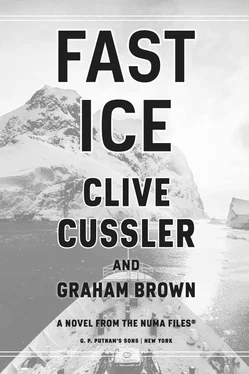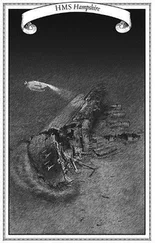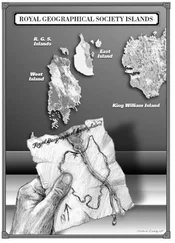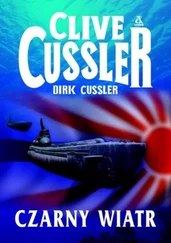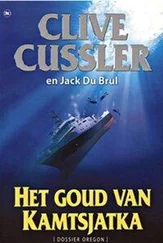The room temperature hovered in the mid-forties and Ryland wore a winter coat and ski pants while sitting at his desk. There were no portholes or skylights, but a false impression of the outside world was granted by a trio of high-definition screens set vertically in one wall. The screens were connected to the vessel’s camera system and often showed views directly outside the ship. At the moment, they displayed the image of a tropical island fronted by sandy beaches and turquoise seas.
Ryland had taken the photo himself several years before while traveling the Indian Ocean aboard his yacht. The families that lived on the island had been in the process of moving to a larger and dryer island a hundred miles away.
They left reluctantly and only because their island flooded more dangerously year after year. With climate change raising the seas and intensifying the storms, the place had become uninhabitable. But once Ryland’s efforts bore fruit, the situation would reverse itself. Ryland expected that island to double in size over the next ten years, growing as the sea level fell. It would become another sanctuary.
Switching the image off, Ryland stood up, walked to the door and pulled it open. Stepping out into the corridor, he turned to the left, heading forward to the ship’s command center.
This corridor was even colder than Ryland’s suite, but it had a different look. Instead of steel, the walls of the corridor were made of the gray-white ice. It was also covered with a cooling mesh, which kept things cold enough that it wouldn’t melt.
Here and there, refrigeration coils could be seen looping in and out of the walls. They ran through the deeper parts of the structure, ensuring that the interior supports remained well below freezing, which was important since the vast majority of the ship he called the Goliath was made out of reinforced ice.
Moving to the end of the corridor, Ryland stepped through a door into the ship’s bridge and control room. This was one of the few compartments in the vessel that allowed direct viewing of the exterior world. A bank of short but wide windows, covered with multiple layers of non-glare film, looked out over the bow of the vessel.
All that could be seen was snow and ice. No funnels, no decks, no anchors or lifeboats. Just ice piled on top of ice and now covered with fresh snow.
Seen from the outside, the ship appeared to be a small iceberg. All the lines were irregular. One side was mostly flat while an oddly shaped section on the port side cantilevered over the sea. A small hill of ice near the bow hid a bank of cameras and several satellite receivers. A larger mound on the stern hid the ship’s helicopter bay. Insulated doors painted white and made to look like snow and ice would have been the envy of any Hollywood set designer. They could be opened at the touch of a button, while the helicopter moved in and out of launch position on a conveyor belt.
The ship’s electrical power came from an array of well-disguised solar cells. But to move the ship’s massive bulk required power and torque. A pair of monstrous diesel engines, each the size of a city bus, took care of that. They drove four large screws hidden under the hull, while a trio of heavyweight thruster pods mounted directly under the center of the keel provided stability, ballast and maneuverability in tight quarters.
Since hot exhaust was an infrared signal that could give them away, the engines were shut down when not in use. And when running, they vented their heat through a complex system that mixed it with supercooled air pumped in through openings located all around the vessel.
Ryland knew his system wasn’t perfect. If the military of any major country started looking for him, they would find him eventually. And once that happened, he had no illusions about the Goliath ’s ability to fight back. Aside from two batteries of anti-aircraft missiles, purchased on the black market in Angola, the ship had no war-making capability.
But, then, it wouldn’t really need it. The Goliath ’s “hull” was thirty feet thick, made from the reinforced ice, which was stronger than hardened concrete. Tomahawk missiles would splatter against its surface like spitballs. Thousand-pound bombs would bounce off the upper deck like acorns hitting the roof of a car. Ryland’s ship would shrug off any attack short of a nuclear weapon and keep plowing forward.
They would get him, of course, but their nearest ships were half a world away at the moment. To win, all Ryland needed to do was get the Goliath into the West Wind Drift, where he could dump the algae now being pumped into the cavernous interior of the ship.
Once he’d accomplished that, any furious bombardments would be for nothing. The new ice age would be seeded and inevitable.
“What’s our status?” Ryland asked the ship’s captain.
The captain deferred to Ober, who stood beside him. Ober had transferred from the oil platform to take charge of loading of the Goliath . It was a tricky operation. The vessel was longer, wider and larger in every respect than Liang’s supertankers.
“Base Zero signaled the commencement of pumping two hours ago,” Ober replied.
“And?”
“It’s eighty miles from here,” Ober reminded him. “Even at the maximum flow rate, we won’t receive the first trickles of water for another hour.”
“Are they pumping full out?”
“That was the indication.”
“Was the indication?” Ryland didn’t like sloppy behavior. “Why don’t you check with them to make sure?”
“We’ve tried,” Ober said. “No response.”
A warning went off. “What do you mean?”
“We’ve tried shortwave and satellite,” the captain explained. “No response on the radio and no handshake from Yvonne’s satellite phone. It’s not linking up. Most likely the storm is interfering.”
“I’ve used a satellite phone in a hurricane,” Ryland insisted.
“A commercial one,” the captain reminded him. “We built our own system so no one could track us. It’s jury-rigged to a data platform from a single satellite. It’s not as robust as the commercial networks.”
The captain’s reasoning was sound, but Ryland sensed danger. “Keep trying,” he said. “I want a report every thirty minutes until you reach them.” He turned back to Ober. “I want you to do anything you can to accelerate the loading process.”
“We already are,” Ober said. “We’re drawing down the pressure on our end of the conduit. With negative pressure on our side and positive pressure on theirs, the water will flow that much faster. We should begin filling the tanks within the hour. Still, we’re looking at five or six hours to take on the full cargo.”
Ryland understood that. It took a while to move a hundred million gallons of water. He looked at the pipeline indicators on a screen. Sensors placed upstream showed the first drops of lake water only twenty miles away. The flow rate and volume were both increasing steadily.
He continued to feel uneasy, yet if anything had gone terribly wrong the pipeline would have been shut down. “Do everything you can to speed that timetable up,” he ordered. “And let me know when you’ve reached my sister.”
55
BASE ZERO
Kurt and Joe stood in the dimly lit habitat module that had once been Yvonne’s command station. A few feet away, Paul lay on a makeshift bed with his leg elevated as Gamay dressed his wound with the medical supplies she’d found.
With Paul in the best possible care they could provide, Kurt turned his attention to Yvonne’s laptop computer, which remained where she’d left it on the desk in the main habitat module. Its screen displayed a schematic of the pipeline’s route, complete with indicators relaying pressures, temperatures and flow rates.
Читать дальше
